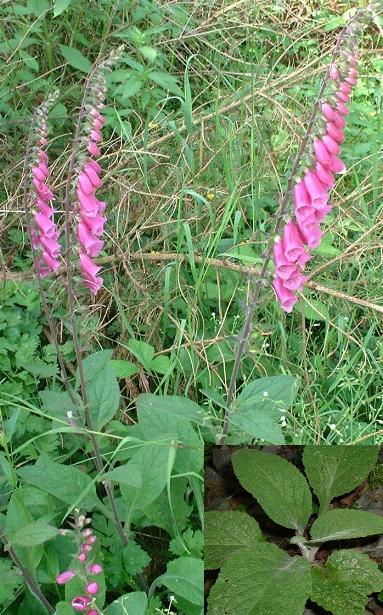FoxgloveScientific Name: Digitalis purpurea |
A biennial, it prefers a shaded spot which is well-drained such as a hedgebank or the edge of woodland. It is a showy plant when in flower and is often allowed to remain in gardens with some more colourful cultivars available. In folklore the fairies were said to put the flowers on the feet of foxes to silence their footfall as they raided the chicken coop.
All parts of the plant are poisonous due to glycosides which can slow the heart-rate. There were some uses in folk medicine as a diuretic for treating dropsy (swelling due to excess fluid, often due to heart failure where a weak heartbeat reduces blood flow). This was the property which lead William Withering, the eighteenth century founder of clinical pharmacology, to spend ten years studying the dosage of foxgloves after isolating it as the active ingredient of a family remedy of a Shropshire herb wife. He also noted that it slowed the heart rate and later the drug digitoxin was extracted from the dried leaves to treat heart failure. Other folk remedies included a salve which was applied for bruises, boils and various skin compaints, and a tea made from infused leaves for sore throats, hence one of the common names, Throatwort.
Theleaves are grey-green and downy with a finely toothed edge. They grow as a basal rosette in the first year and are attached spirally to the flowering stem which develops in the second year. Some plants can be multi-stemmed. The purple forms usually have a reddish tinge at the base of the leaves whereas the white forms do not.
Flowering occurs from June to September in the second season. A tall spike grows up to 1.5 metres with up to 80 tubular magenta and sometimes white bells in a terminal cluster on one side which open rom the bottom upwards, these are pollinated by bumble-bees. The white forms are recessive so must be isolated from the purple-flowered ones to prevent cross-pollination, if they are to produce seed.
If it is allowed to seed the surrounding area will be covered in masses of seedlings for a number of years afterwards, so the fading flower spike or the entire plant must be removed if it has been allowed to bloom. The seedlings are easily uprooted and any remaining roots will not regrow provided the growing point at soil-level is removed. A systemic herbicide such as Glyphosate will work, weedkillers work best in the rosette stage during the first year.
Other plants with similar leaves include Green Alkanet, Comfrey, Tuberous Comfrey and Borage
Follow these links for further details on Weeds, Weed Removal and Weed Prevention.
